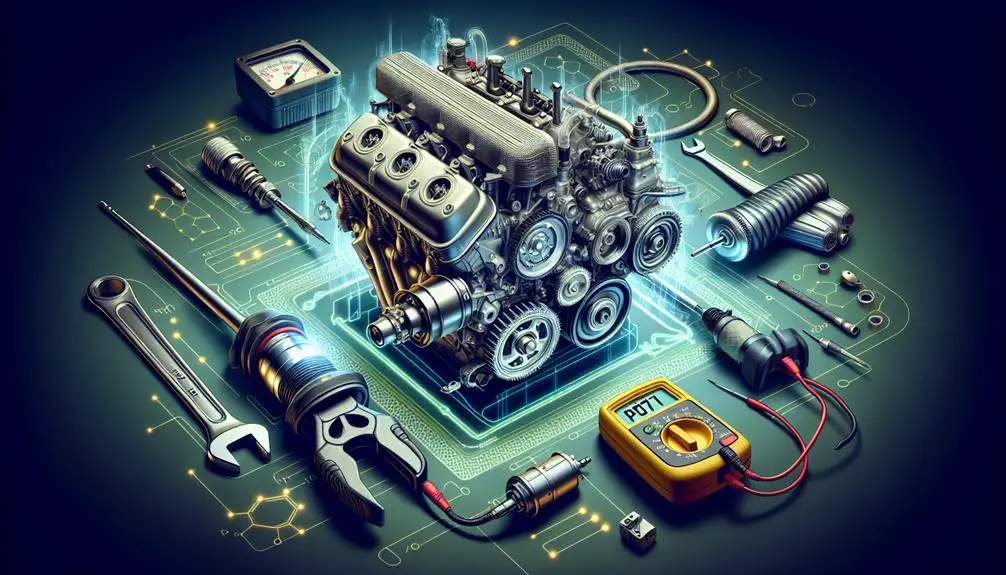To fix the P0171 code on a Toyota Corolla, you should check for vacuum leaks. Inspect the fuel system thoroughly to ensure there are no issues affecting fuel delivery. If the problem persists, consider replacing the oxygen sensor. These steps address the engine running too lean and can help reset the engine light.
This structured approach will help in efficiently diagnosing and resolving the P0171 trouble code on your Toyota Corolla.
Understanding Code P0171

Code P0171 means your Toyota Corolla is running with too much air and not enough fuel. This can cause problems like rough idling and poor fuel efficiency. The engine has sensors that detect when the air to fuel ratio is off. When there's too much air, the P0171 code is triggered. This usually happens because of issues in the fuel system or air intake components.
To fix this, it's important to find the exact problem. It might involve checking the fuel injectors for blockages, making sure the fuel pressure is right, or ensuring the mass airflow sensor is working properly. Fixing Code P0171 means diagnosing and repairing the specific issue causing the lean condition, not just making quick fixes. This helps make sure your Corolla runs well.
Checking for Vacuum Leaks
Understanding Code P0171 is important. It suggests checking for vacuum leaks because these leaks can cause problems. Vacuum leaks allow extra air into the engine, which messes up the air-fuel mix, leading to a lean condition that Code P0171 shows.
Here's how to check for vacuum leaks in your Toyota Corolla.
First, visually inspect all vacuum hoses and connections for wear, tear, or disconnections. Sometimes, the problem is just a loose or cracked hose.
If you can't find the problem by looking, you might need a smoke test. This test involves putting smoke into the vacuum system and seeing where it comes out. If smoke comes out somewhere, it means there's a leak. This method works well but needs special equipment.
Here's a quick summary of what to do when checking for vacuum leaks:
- Visual Inspection: Look for damaged or disconnected hoses.
- Smoke Test: Look for smoke coming out of hoses or connections to find leaks.
Inspecting the Fuel System

To fix Code P0171 on your Toyota Corolla, which shows the fuel mixture is too lean (more air, less fuel), check the fuel system as follows:
- Fuel Filter: Look at the fuel filter first. If it's blocked, fuel can't flow well, causing a lean mix. Replace it if it's dirty or old.
- Fuel Pump: The fuel pump sends fuel to the engine. If it's weak, not enough fuel gets to the engine, leading to the P0171 code. Listen for odd sounds from the pump and check the fuel pressure to make sure it's right for a Toyota.
- Fuel Injectors: If fuel injectors are dirty or broken, they can't give the right amount of fuel to the engine. Test each injector's resistance with a multimeter and match it against the correct values. Think about getting them cleaned if they're blocked.
- Fuel Pressure Regulator: This part keeps the fuel pressure steady. If it's not working right, it can change the pressure, messing up the fuel-air mix. Look for any leaks or damage, and test the vacuum line to make sure it works properly.
Replacing the Oxygen Sensor
When dealing with a P0171 code in your Toyota Corolla, check the oxygen sensor. This sensor is important for making sure your car runs efficiently. It might be causing the problem.
First, find the oxygen sensor in the exhaust system. Your car might have more than one sensor either before or after the catalytic converter. Use a diagnostic tool to figure out which sensor isn't working right.
Before you start, make sure the engine is cool to prevent burns. Turn off the battery for safety, then find the oxygen sensor. You'll need an oxygen sensor socket and a wrench to remove the sensor without damaging anything.
Unscrew the faulty sensor. If it's hard to remove, use penetrating oil to loosen it. Before installing the new sensor, check that it matches the old one. Screw in the new sensor by hand first to avoid damaging the threads, then tighten it with the wrench.
After that, reconnect the battery. Make sure everything is put back correctly and there are no loose parts.
Changing the oxygen sensor can improve your Corolla's performance. This task requires some tools and patience but is important for fixing the P0171 code.
Resetting the Engine Light

Resetting the engine light after fixing the P0171 code in your Toyota Corolla is important. It clears error codes from the computer, helping it monitor the car properly. Here's how to do it:
- Use an OBD-II Scanner
- Connect an OBD-II scanner to the port under the dashboard. Turn the ignition to 'ON' but don't start the car. Follow the scanner's steps to clear codes and turn off the engine light.
- Disconnect the Battery
- Without a scanner, you can reset the computer by disconnecting the car battery. Turn off the car, remove the negative battery terminal, and wait 15 minutes. This resets the computer. Reconnect and start the car; the engine light should be off.
- Drive Your Car
- Driving for 50 to 100 miles might also reset the light as the computer checks and finds no issues.
- Check for Other Issues
- If the light stays on, check for unresolved problems or see a mechanic.
Resetting the light ensures your Corolla runs well and avoids emissions problems.
Conclusion
You're fixing code P0171 on your Toyota Corolla. First, check for any air leaks. Next, look at the fuel system. You might also need to change the oxygen sensor.
Don't forget to reset the engine light to see if your fixes worked. If the light turns on again, go through the steps another time or ask someone who knows a lot about cars for help.
Be patient and pay attention to what you're doing, and your Corolla will run well again soon.
